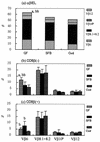Differential roles of segmented filamentous bacteria and clostridia in development of the intestinal immune system
- PMID: 10377132
- PMCID: PMC116537
- DOI: 10.1128/IAI.67.7.3504-3511.1999
Differential roles of segmented filamentous bacteria and clostridia in development of the intestinal immune system
Abstract
The presence of microflora in the digestive tract promotes the development of the intestinal immune system. In this study, to evaluate the roles of two types of indigenous microbe, segmented filamentous bacteria (SFB) and clostridia, whose habitats are the small and large intestines, respectively, in this immunological development, we analyzed three kinds of gnotobiotic mice contaminated with SFB, clostridia, and both SFB and clostridia, respectively, in comparison with germfree (GF) or conventionalized (Cvd) mice associated with specific-pathogen-free flora. In the small intestine, the number of alpha beta T-cell receptor-bearing intraepithelial lymphocytes (alpha betaIEL) increased in SFB-associated mice (SFB-mice) but not in clostridium-associated mice (Clost-mice). There was no great difference in Vbeta usage among GF mice, Cvd mice, and these gnotobiotic mice, although the association with SFB decreased the proportion of Vbeta6(+) cells in CD8beta- subsets to some extent, compared to that in GF mice. The expression of major histocompatibility complex class II molecules on the epithelial cells was observed in SFB-mice but not in Clost-mice. On the other hand, in the large intestine, the ratio of the number of CD4(-) CD8(+) cells to that of CD4(+) CD8(-) cells in alpha betaIEL increased in Clost-mice but not in SFB-mice. On association with both SFB and clostridia, the numbers and phenotypes of IEL in the small and large intestines changed to become similar to those in Cvd mice. In particular, the ratio of the number of CD8alpha beta+ cells to that of CD8alpha alpha+ cells in alpha betaIEL, unusually elevated in the small intestines of SFB-mice, decreased to the level in Cvd mice on contamination with both SFB and clostridia. The number of immunoglobulin A (IgA)-producing cells in the lamina propria was more elevated in SFB-mice than in Clost-mice, not only in the ileum but also in the colon. The number of IgA-producing cells in the colons of Clost-mice was a little increased compared to that in GF mice. Taken together, SFB and clostridia promoted the development of both IEL and IgA-producing cells in the small intestine and that of only IEL in the large intestine, respectively, suggesting the occurrence of compartmentalization of the immunological responses to the indigenous bacteria between the small and large intestines.
Figures







References
-
- Badiner G, Goodman T G, Lefrancois L. Selection of intestinal intraepithelial lymphocyte T cell receptors: evidence for a dynamic tissue specific process. Int Immunol. 1993;5:223–226. - PubMed
-
- Balk S P, Ebert E C, Blumenthal R L, Mcdermott F V, Wucherpfenning K W, Landau S B, Blumberg R S. Oligoclonal expansion and CD1 recognition by human intestinal intraepithelial lymphocytes. Science. 1991;253:1411–1415. - PubMed
-
- Barnard J A, Warwick G J, Gold L I. Localization of transforming growth factor β isoforms in the normal murine small intestine and colon. Gastroenterology. 1993;105:67–73. - PubMed
MeSH terms
Substances
LinkOut - more resources
Full Text Sources
Other Literature Sources
Molecular Biology Databases
Research Materials
Miscellaneous

